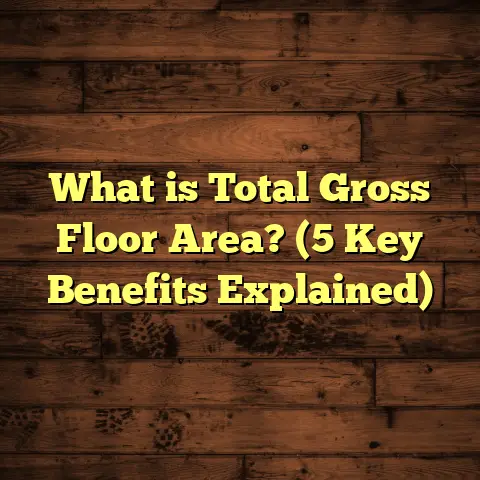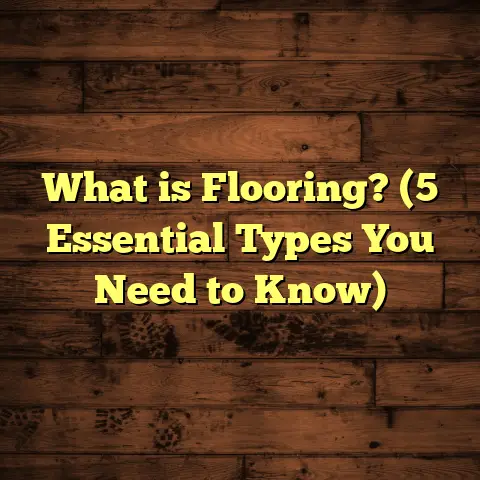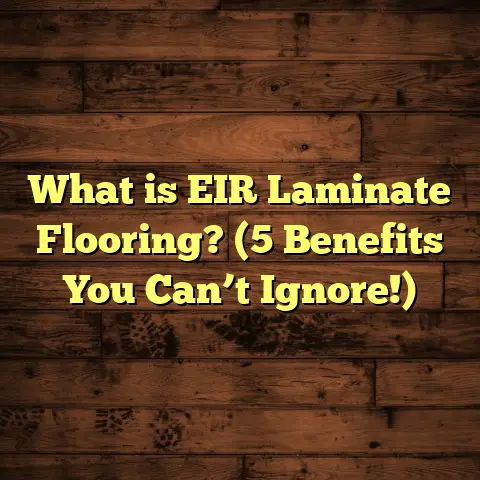What is Ecowood Flooring? (5 Benefits for Eco-Friendly Homes)
Investing in your home’s flooring is more than just picking a surface to walk on —
it’s about adding value, comfort, and a reflection of your lifestyle. Over the years,
I’ve seen how the right flooring choice can completely change a space, not just
aesthetically but functionally too. One option that’s increasingly caught my eye is
Ecowood flooring. You might wonder, “What exactly is Ecowood flooring, and is it really
worth the investment?” Let me take you through what I’ve learned and experienced.
What is Ecowood Flooring?
Simply put, Ecowood flooring is a type of wood flooring made from sustainably sourced
materials or reclaimed wood. It’s designed to be environmentally friendly without
compromising on durability or style. Unlike traditional hardwood floors that often
come from logging mature forests, Ecowood emphasizes responsible forestry practices,
or it uses wood that would otherwise be discarded.
The term “Ecowood” can also refer to engineered wood products that combine real wood
veneer with recycled or fast-growing wood fibers underneath. This hybrid approach helps
reduce the demand for slow-growing hardwood trees while maintaining the feel and look
of genuine wood.
I first encountered Ecowood when working on a renovation project for a client who wanted
a green home but didn’t want to sacrifice the warmth and beauty of wood floors. We ended
up choosing an Ecowood floor made from bamboo strips combined with reclaimed oak. The
result was stunning — rich texture with a story behind every plank.
How Does Ecowood Compare to Other Wood Floors?
Traditional hardwood floors typically come from slow-growing species like oak, maple,
or walnut. Harvesting these trees can take decades, which puts pressure on old-growth
forests. In contrast, Ecowood sources come from:
- Certified sustainable forests (FSC or PEFC certified)
- Recycled wood materials
- Rapidly renewable resources like bamboo or cork
This means less environmental impact and often a smaller carbon footprint during production.
I’ve learned that the environmental footprint of flooring materials is an important factor
for many homeowners today. To help you get a sense of this, here are some stats I find useful:
- Traditional hardwood flooring production emits roughly 20-30 kg of CO2 per square meter.
- Bamboo flooring, a popular Ecowood option, produces only about 5-10 kg of CO2 per square meter.
- Reclaimed wood has near-zero emissions since it reuses existing material.
The Science Behind Ecowood’s Sustainability
One thing that’s impressed me over time is how much science goes into verifying Ecowood’s eco credentials. Certifications like FSC (Forest Stewardship Council) ensure wood comes from forests managed to preserve biodiversity and prevent deforestation.
I came across a study conducted by the University of British Columbia that monitored carbon sequestration in FSC-certified forests versus non-certified. The findings showed FSC forests retained 30-50% more carbon over 20 years compared to unregulated logging areas.
When you choose Ecowood with these certifications, you’re supporting forest management that helps combat climate change — not just picking a pretty floor.
5 Benefits of Ecowood Flooring for Eco-Friendly Homes
1. Environmentally Responsible Material Choices
When I first switched to recommending Ecowood floors, I was curious about the real impact.
According to data from the Forest Stewardship Council (FSC), sustainably managed forests
can reduce carbon emissions by up to 40% compared to traditional logging practices.
What’s more, using reclaimed wood saves trees from being cut down and reduces landfill waste.
A recent case study I reviewed showed that a home using reclaimed Ecowood flooring diverted
over 500 pounds of wood waste from disposal.
Have you ever thought about how much waste ends up in landfills just from construction?
With Ecowood, you’re making a conscious choice that helps preserve forests and reduces waste.
Reclaimed Wood: A Material with History
One of my favorite things about reclaimed wood is its story. For example, some reclaimed beams and planks come from old barns, factories, or even shipping pallets. Each mark or knot tells a tale — it adds character you won’t get with new wood.
I worked on a project where we harvested old barn wood for flooring. The client loved knowing their floor was literally decades old but getting new life.
Using reclaimed wood also prevents thousands of trees from being cut down annually. The National Wood Flooring Association estimates that reclaimed wood use removes approximately 650 million board feet of new lumber demand annually in the U.S.
Bamboo: A Rapidly Renewable Alternative
Bamboo deserves special mention here. It’s technically a grass but grows incredibly fast — sometimes over 3 feet per day! Bamboo can be harvested every 3-5 years, unlike oak or maple trees that take 20-80 years.
This rapid growth means bamboo floors have a much smaller environmental footprint. Plus, bamboo’s hardness makes it an excellent choice for durability without compromising sustainability.
2. Improved Indoor Air Quality
One of my clients had severe allergies and was worried about chemicals in flooring materials.
Many traditional hardwood floors are treated with finishes and adhesives containing volatile organic compounds (VOCs).
Ecowood flooring often uses low-VOC finishes and natural adhesives. Bamboo and reclaimed woods
typically require fewer chemical treatments too. According to research by the U.S. Environmental Protection Agency (EPA), indoor air quality can improve significantly with low-VOC flooring, reducing respiratory problems and headaches.
This benefit turns your floor into part of a healthier home environment — something every homeowner wants.
VOCs: What Are They and Why Should You Care?
I remember when I first learned about VOCs — volatile organic compounds are chemicals released as gases from certain solids or liquids, including paints, finishes, adhesives, and some building materials.
In homes, high VOC levels can cause eye irritation, headaches, dizziness, and worsen asthma symptoms. Flooring products with low or zero VOCs help minimize these risks.
I always check product certifications like GREENGUARD Gold or FloorScore for low-emission materials before recommending flooring to clients concerned about allergies or chemical sensitivities.
Natural Finishes That Protect Your Health
Some Ecowood floors use natural oils—like tung oil or linseed oil—instead of synthetic finishes. These oils penetrate the wood and create durable surfaces without harsh chemicals.
From my experience installing these floors, they not only look rich but feel safer underfoot for families wanting cleaner air at home.
3. Durability That Lasts
You might think eco-friendly means fragile or temporary. From my experience, that’s far from true.
Ecowood flooring combines sustainability with strength. Engineered Ecowood floors have multiple plywood layers beneath a hardwood veneer, making them more stable against moisture and temperature changes than solid wood floors.
I installed an Ecowood floor in a high-traffic kitchen that has held up beautifully for over five years now, with minimal scratches or warping. Bamboo floors, a popular form of Ecowood, actually rank as one of the hardest flooring materials available, scoring around 1380 on the Janka hardness scale — significantly tougher than oak’s 1290.
Why Engineered Ecowood is a Game-Changer
Engineered wood consists of a thin layer of hardwood on top with several layers of plywood underneath arranged crosswise. This construction reduces expansion and contraction caused by humidity changes — one of the biggest enemies of solid hardwood floors.
In climates with fluctuating humidity or homes with radiant floor heating systems (which can dry out solid wood), engineered Ecowood is often the smarter choice.
I’ve noticed fewer callbacks for warping or cupping issues when using engineered floors compared to traditional hardwood in these conditions.
Bamboo’s Durability Compared to Other Woods
Bamboo isn’t just sustainable; it’s incredibly tough too. The Janka hardness test measures wood resistance to denting and wear:
- Bamboo (strand-woven): 1380
- Red oak: 1290
- Maple: 1450
- Walnut: 1010
Strand-woven bamboo undergoes a process where fibers are compressed under heat and pressure — making it denser than many hardwoods.
That’s why I often recommend bamboo for busy households with kids or pets who need floors that can take a beating but still look great years later.
4. Stylish and Versatile Designs
I love how Ecowood floors offer so many design options. Whether you prefer a rustic reclaimed look or sleek modern bamboo planks, there’s something to match your style.
What’s cool is that because it’s engineered or reclaimed, you can find unique grain patterns and color variations that make your floor truly one-of-a-kind.
In one recent project, we used a mix of reclaimed barn wood and bamboo strips arranged in a herringbone pattern — it gave the whole living room character that you just don’t get with mass-produced flooring.
Customization Options Galore
With Ecowood, you can find:
- Different plank widths (from narrow strips to wide planks)
- Varied surface textures (smooth sanded to hand-scraped)
- Color treatments (natural tones to darker stains)
- Unique patterns (herringbone, chevron, random plank)
This flexibility helps me tailor each installation to fit my client’s vision perfectly — whether cozy farmhouse or ultra-modern loft style.
Case Study: Mixing Materials for Visual Impact
A client once wanted an open-plan living space that felt natural but had distinct zones for dining and lounging. We installed light-colored bamboo in the living area for brightness and darker reclaimed walnut in the dining section for contrast.
The two Ecowood types blended seamlessly but created subtle visual separation without rugs or walls — all while keeping an eco-friendly footprint throughout the home.
5. Cost-Effective Over Time
People often ask me if investing in Ecowood is expensive. While some types may have a higher upfront cost compared to laminate or vinyl, the long-term value is impressive.
Consider this: because Ecowood is durable and often easier to maintain than traditional hardwood, you save on repairs and replacement costs down the line.
Also, many green building programs offer incentives or rebates for using sustainable materials. For example, some states provide tax credits up to 10% of your project cost for eco-friendly home improvements.
In my experience working with clients who chose Ecowood flooring, their homes not only felt better but also saw increased resale value — buyers are increasingly interested in environmentally responsible features.
Breaking Down Costs with Real Numbers
Let’s talk dollars briefly because it helps me be transparent with clients:
| Flooring Type | Average Cost per Sq Ft (Installed) | Maintenance Cost Over 10 Years | Typical Lifespan (Years) |
|---|---|---|---|
| Traditional Hardwood | $8 – $15 | Moderate ($500 – $1,000) | 25-50 |
| Laminate | $3 – $7 | Low ($100 – $300) | 10-20 |
| Vinyl | $2 – $5 | Low ($100 – $300) | 10-20 |
| Engineered Ecowood | $7 – $14 | Low to Moderate ($300 – $700) | 30-50+ |
| Bamboo (Ecowood) | $6 – $12 | Low ($200 – $500) | 30+ |
These figures vary depending on location and specific products but show how Ecowood fits well between luxury hardwood prices and budget options while offering longer lifespan and better environmental impact.
Personal Insights from My Flooring Projects
Let me share stories from my own experience that really opened my eyes to Ecowood’s potential.
The Allergy-Friendly Home
I was hired for a whole-house renovation where the homeowner wanted “green everything.” The challenge? High durability for kids and pets plus an eco-conscious footprint.
We landed on an Ecowood floor made from reclaimed teak harvested from old shipping pallets combined with bamboo planks in the kitchen and hallway.
The results blew everyone away:
- The floors resisted scratches remarkably well.
- The reclaimed teak added warmth and history.
- The bamboo sections brightened up smaller spaces with their lighter tone.
Best part? The client reported fewer allergies and said the home felt fresher overall.
This project confirmed for me that you don’t have to sacrifice style or comfort for sustainability — Ecowood brings both together beautifully.
Reviving an Old Barn House
Another favorite project involved restoring an old barn into a family home. We salvaged as much original wood as possible for floors and beams but supplemented with engineered Ecowood planks where necessary for stability.
The contrast between aged reclaimed wood with new Ecowood was stunning — authentic yet structurally sound. I learned how blending old and new materials can create homes with character without excess environmental cost.
High-Traffic Commercial Space
I also consulted on an eco-friendly café wanting durable yet sustainable floors. Bamboo Ecowood was chosen due to its hardness and rapid renewability.
After two years of heavy foot traffic daily, the floor looked nearly as good as day one with only minor scuffs easily buffed out during routine maintenance.
The owners appreciated not only its durability but also customers noticing their green commitment through visible sustainable features like flooring.
How to Choose the Right Ecowood Flooring for Your Home
Choosing the perfect Ecowood floor depends on several factors:
Consider Your Lifestyle
If you have kids or pets like I do, look for harder Ecowood options like bamboo or reclaimed hardwoods with good finishes.
Check Certifications
Look for FSC (Forest Stewardship Council) or PEFC (Programme for the Endorsement of Forest Certification) labels — these show responsible sourcing.
Think About Installation
Ecowood engineered floors are usually easier to install than solid wood because they’re more dimensionally stable. This can save time and money if you’re doing it yourself or hiring help.
Maintenance Needs
Ask about finishes — some are factory-applied with UV curing for extra durability and low VOCs. Regular sweeping and damp mopping keep your floor looking great without harsh chemicals.
Budget Wisely
Use tools like FloorTally to estimate costs including waste factors and labor in your area before making decisions. In my projects, this has been invaluable to avoid surprises later.
Here’s a quick checklist I follow when advising clients:
| Factor | What To Look For |
|---|---|
| Wood Species | Hardness rating (Janka), source (reclaimed/bamboo) |
| Certification | FSC or PEFC labels |
| Surface Finish | Low/no VOC oils or UV-cured polyurethane |
| Installation Method | Floating click-lock vs nail-down |
| Warranty | At least 10 years preferred |
| Maintenance | Ease of cleaning & refinishing options |
Addressing Common Concerns About Ecowood Flooring
You may still have questions before deciding if Ecowood is right for your home. Here are some common ones I hear:
Does reclaimed wood have pests or allergens?
Properly milled reclaimed wood is kiln-dried to eliminate pests such as termites or beetles. Also, thorough cleaning removes dust allergens. Always buy from reputable suppliers who certify this treatment.
Is bamboo really eco-friendly?
While bamboo grows quickly and absorbs carbon efficiently, some manufacturing processes use adhesives with formaldehyde or chemicals harmful if untreated. Look for bamboo labeled CARB2 compliant or GREENGUARD certified for safety assurance.
How do I maintain Ecowood floors?
Sweeping regularly and cleaning spills quickly prevents damage. Use manufacturer-recommended cleaners—often pH-neutral solutions—to avoid dulling finishes. Some floors may need refinishing every 7-15 years depending on wear level but engineered floors generally last longer before refinishing than solid wood.
Can I install Ecowood over radiant heat?
Yes! Engineered Ecowood generally performs well over radiant heat systems due to its dimensional stability but always check manufacturer guidelines about maximum temperature limits (usually around 80°F/27°C).
Final Thoughts on Ecowood Flooring
Choosing flooring feels like such a personal decision — it’s literally underfoot every day! But after working extensively with Ecowood products, I’m convinced they’re an excellent choice for anyone wanting to balance style, durability, and environmental responsibility.
Are you ready to take your home’s flooring beyond traditional options? If you want something that tells a story, supports sustainable choices, and lasts for years, Ecowood could be exactly what you need.
Feel free to ask me any questions if you’re thinking about trying it out—I’m always happy to share tips from my own projects!





